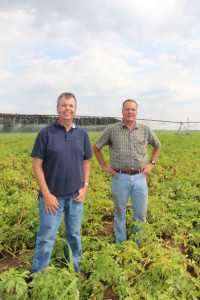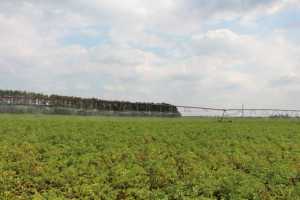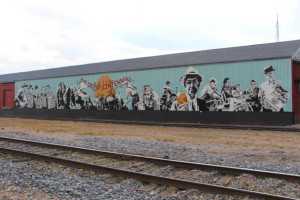Sustainability Is A Way Of Life For Vegetable Producer Okray Family Farms
A few years ago when the word “sustainability” was first tossed around, its definition was a little ambiguous, meaning different things to different people. Today, things couldn’t be more clear. Sustainability is a way of life for growers who want to see their businesses continue to grow and prosper. To be sustainable, growers must remain profitable and operate their farms in a way that preserves resources and creates efficiencies.

Sustainability is a key component at Okray Family Farms in Wisconsin. Pictured here (from left) Jim Okray, vice president of operations, and Rich Rashke, farm manager.
Top 100 Grower Okray Family Farms in Plover, WI — a farm that has been growing potatoes, sweet corn, and other cash crops for more than 100 years — is no stranger to this concept or what it means to the future of the operation. Rich Rashke, who is in his 10th season as farm manager, says virtually everything Okray Family Farms does encompasses sustainability.
When the farm first embraced the concept, Rashke says avoiding crop loss was one of the biggest goals, but that has since expanded to include everything from planting preparations to postharvest field and equipment maintenance.
“Sustainability is crucial and completely [determines] how we maintain our fields [throughout the year], our equipment, and our facilities,” he says.
Precision Tools
To become more efficient with field operations, which includes tilling, planting, and fertilizer and irrigation applications, the farm uses precision agriculture products from Trimble. According to Rashke, the tools paid for themselves in about two years by eliminating variables and improving efficiencies.
The farm began using precision technology about seven years ago with the addition of steering systems to two large articulated tractors used for tillage work. Since that time, a Trimble Autopilot system has been added to six more tractors used for field work.
“We find with the help of Trimble and other GPS systems, we can diversify our tilling program to accommodate multiple field operations simultaneously and maintain consistent repeatability for every field and every application — every year,” he says. “Plus, using the steering function reduces operator fatigue, which allows [him] to be more attentive to the equipment and the current application. We’re able to streamline processes in the field, which reduces our overall operation costs and, ultimately, our carbon footprint.”
To apply fertilizers, the farm uses variable rate application along with broadcasting. As a result, Rashke says with precision tools, they can be within 2% to 3% of the target application. “Using the right amount of product and getting the fertilizer only where it needs to be reduces the risk of overapplication, which helps avoid leaching through the soil and reduces costs,” he adds.
Similarly, variable rate irrigation enables the farm to apply water at different rates for a field, depending on specific soil conditions.
“With computerized irrigation systems, we take advantage of the variable rate technology for each specific field and soil condition so we are more precise,” he says. “Plus, our water management has improved and resources are preserved.” (See “Competition For Water Resources.”)
Other Sustainable Tactics
In addition to using precision technology, Okray Family Farms employs other tactics to increase its level of sustainability. In 2012, the operation created a carbon footprint map and devised a plan to reduce carbon emissions during the next decade. The Cool Farm Tool (CFT), developed by Unilever, was used to make the map. (For more information on the CFT, go to coolfarmtool.org.)
Upgrading equipment is helping them achieve this goal. For example, using tractors that use biofuels decreases emissions, and the addition of Tier 4 engines in new trucks is a step toward reducing the farm’s carbon footprint, explains Rashke.
He also cites the Central Wisconsin Windshed Partnership as another sustainability effort. The program was started at the Hancock Agricultural Research Station in 2000, and since that time the farm has added more than 25 miles of windbreaks along field edges.
“It started out as a windbreak to reduce field erosion,” Rashke recalls. “Along the edges of fields, [the windbreak] not only helps with erosion, it adds to wildlife habitats that harbor along field edges. We feel continually adding windbreaks benefits our operation and restores some of the natural resources.”
Reducing soil erosion with cover crops is another sustainability tactic employed by the farm.
“We try to do what we can, knowing that there are times of the year where the ground is bare,” Rashke explains. “With cover crops, we try to protect as much land as possible from erosion. It helps us with weed control and it helps rebuild the soil.”
Quality Packaging
In the packing shed, the installation of a new box machine that cost upwards of $700,000 was a big addition to the farm’s sustainability efforts. The state-of-the-art equipment looks for internal defects in potatoes and has seven lanes for sizing and boxing, which increases production volume capabilities.
As there are not many packing sheds with this type of equipment, Rashke says that it gives the farm an advantage: Only high-quality potatoes are being packed and delivered. The farm also packages potatoes in many different sizes, and very few suppliers in the area can offer that flexibility, he adds.
“Our current customers are confident that they will receive a higher-quality product and our quality assurance,” he says. “We try to focus in on what people want. It isn’t just about the quality of the product; it’s about the quality of the product and its desired packaging.”
Competition For Water Resources

Computerized irrigation systems are used to improve water management at Okray Family Farms.
Photo credit: Rosemary Gordon
Water usage can be a tricky situation on the farm, especially when the public is involved. Rich Rashke, farm manager at Okray Family Farms in Plover, WI, cites a situation involving the Little Plover River and the use of high-capacity wells.
A consensus among a local group was that the use of high-capacity wells was causing the river go dry, he explains. As a result, the farm is working with the Wisconsin Potato & Vegetable Growers Association and other resources from the University of Wisconsin-Madison on studies that will be conducted to determine rain amounts, the amount of water crops use, what trees use, and what residents use.
“Hopefully the results will help in determining the impact of agriculture on this specific resource,” adds Rashke.
On top of that, he says a local township in the area is requesting conditional-use permits for any new center pivot irrigation system or high-capacity wells. Okray Family Farms won’t be impacted now, he says, as zoning changes won’t affect land they’re currently farming. Down the line, however, if they want to purchase land, it may not be zoned for irrigation and rezoning may be difficult.
“When the public sees the irrigators as they drive by, they may assume water usage is being abused or wasted by growers,” Rashke says. “I understand the concern people may have, but it’s unfortunate. As one of many growers in Wisconsin, who collectively produce more than 2% of the nation’s processed vegetables, we all need to understand and appreciate the benefit of that water use, the crops it helps produce, and the billions of dollars it adds to our state’s economy.”
Okray’s State Of The Industry
At Okray Family Farms in Plover, WI, potato production has remained relatively unchanged over the last six to eight years. Accord-ing to Jim Okray, vice president of farm operations, however, potato acreage is down from about a decade ago.
Why? The answer is simple: because yields have increased. The farm currently grows various reds, yellows, and russets such as Norkotah, Goldrush, and Silverton.
To stay on track, Okray Family Farms matches its production to customer needs. All the spuds are for fresh market, and the farm handles all packaging and brokering. They also pack potatoes for other growers.
Okray recalls when the United Potato Growers of America was formed in 2005 to better align supply and demand.
“There was a conscious effort to manage supply to meet demand and it worked for quite a while,” he explains. ”It was a good idea to have that mindset to not overproduce. You can see what happened in the years there was overproduction. The price takes such a hit for just a little bit of oversupply with demand being constant.”
Okray says the operation knows how many acres will be dedicated to potatoes from year to year unless new customers have been added.
“For our main customers, who account for about 70% of our business or better, we have a pretty good idea what their needs are going to be,” he explains. “We try to grow the varieties that are going to give us the best output of Number 1 potatoes.”
Acreage has been on the rise for the other crops the farm produces — beans, peas, and sweet corn. In 2011, total acreage topped out at 6,500. The next year it was about 7,150.
Total acres were increased by going to a longer crop rotation, he explains. Previously, the farm had been on a three-year rotation and opted to move to four years as field rotation among potatoes, sweet corn, peas, and beans not only benefits the soil, it also reduces the spread of disease.
“We are now in a four-year rotation and that helps with the quality and quantity of the crops,” Okray adds.
Okray Family Farms At A Glance

Okray Family Farms celebrated its 100th anniversary in 2005.
Photo credit: Rosemary Gordon
At The Helm: Mike Finnessy, president; Jim Okray, vice president of operations; Richard Okray, secretary/treasurer; Chris Okray, vice president of Human Relations; Joseph J. Okray, vice president emeritus; and Rich Rashke, farm manager.
Location: Plover, WI
2014 crops and acreage: Potatoes (1,800 acres), snap beans (2,000 acres), peas (550 acres), sweet corn (3,000 acres), and small grains (550 acres)
Customers: Potatoes are for fresh market; the other vegetables are for the processing industry.










